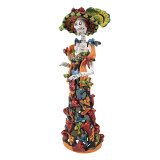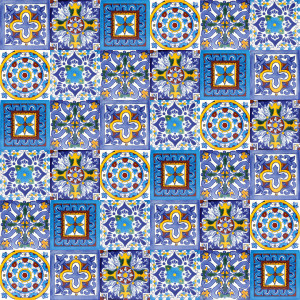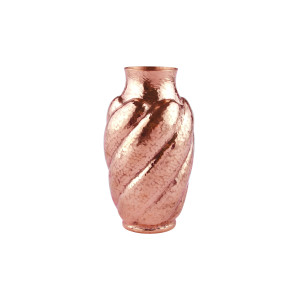Catrina Colibri - traditional La Catrina figure
- The original La Catrina figurine
- Hand made and hand painted by Mexican artists
- Dimensions H 58, W 20 cm
- Securely packed
- Delivered from stock in Poland
Catrina Colibri figurine
Catrina Colibri figurine referring to the symbolism of La Catrina. Height 58 cm, base diameter close to 20 cm. The head, or rather the skull, is adorned with a colorful hat, and the figure is dressed in a multicolored evening gown. The colors that the artist used for the hat and dress refer to the colors used in the Mayan and Aztec times; they are mainly shades of blue, yellow, orange, and green.
Each element of the figurine was made in a separate form, while details such as frills and braids were hand-made by the craftsman from a special mass. The figurine was also hand-painted by the artist and then burned in a specially designed oven. At the final stage, the figurine was varnished, which allowed to achieve a wonderful decorative effect.
La Catrina figurines
La Catrina is a permanent element of Mexican culture that refers to the symbolism of death. Mexicans perceive their holiday of the dead, Día de Muertos, in a different way than Europeans. Mexicans treat death as a stage of life and look forward to meeting the spirits of their ancestors. Elements of colorful, sometimes smiling skulls or even whole silhouettes of skeletons clad in rich robes can be found in most Mexican houses. In addition to decorative elements such as figurines, the skull is often a pattern found on glazed tiles, vases, and bowls. Catrinas do not frighten, rather they bring a smile to the face of a Mexican.
Catrina Colibri figurine referring to the symbolism of La Catrina. Height 58 cm, base diameter close to 20 cm. The head, or rather the skull, is adorned with a colorful hat, and the figure is dressed in a multicolored evening gown. The colors that the artist used for the hat and dress refer to the colors used in the Mayan and Aztec times; they are mainly shades of blue, yellow, orange, and green.
Each element of the figurine was made in a separate form, while details such as frills and braids were hand-made by the craftsman from a special mass. The figurine was also hand-painted by the artist and then burned in a specially designed oven. At the final stage, the figurine was varnished, which allowed to achieve a wonderful decorative effect.
La Catrina figurines
La Catrina is a permanent element of Mexican culture that refers to the symbolism of death. Mexicans perceive their holiday of the dead, Día de Muertos, in a different way than Europeans. Mexicans treat death as a stage of life and look forward to meeting the spirits of their ancestors. Elements of colorful, sometimes smiling skulls or even whole silhouettes of skeletons clad in rich robes can be found in most Mexican houses. In addition to decorative elements such as figurines, the skull is often a pattern found on glazed tiles, vases, and bowls. Catrinas do not frighten, rather they bring a smile to the face of a Mexican.
Product Details
- Product code: AVE-FG-14
- Manufacturer: Cerames
- Colour Multicolor
- Material Ceramic
- Country of origin Mexico
You might also like





















